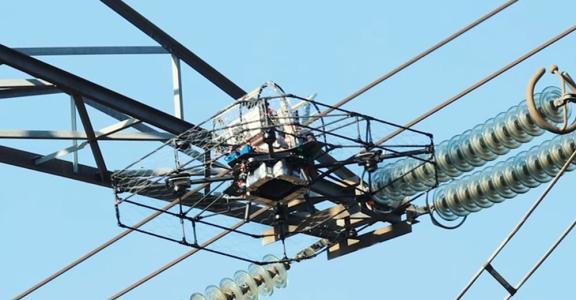Ampacimon achieves voltage-free installation with drones
Ampacimon specialises in grid monitoring solutions. Under the Skywin cluster project 'SW_AMPASENS', the company and its partners Skydrone, Multitel and Sirris jointly developed an innovative solution to install Ampacimon sensors on high-voltage lines by using drones. This initiative stemmed from the need to optimise the use and capacity of high-voltage lines, while overcoming the technical challenges inherent to the installation of these sensors using traditional methods.
Ampacimon's sensor solution, developed over more than 10 years, measures the electric current and mechanical voltage of high-voltage lines in real time. These self-powered sensors enable maximum and safe energy transfer by monitoring the subsidence and temperature of the high-voltage line.
Ampacimon was now looking for a way to install those sensors on a high-voltage line without shutting the line down. The solution: drones.
Fast, efficient and safe
Traditional installation of the sensor unit on the high-voltage line usually involves complex expensive operations, such as the use of ladders, boom trucks or even helicopters. Besides, the line has to be shut down completely. This entails very high indirect costs for the network operators related to shutting down the lines.
Installation using a drone greatly simplifies this process. It is the fastest and most efficient solution that can be implemented in record time. The drone installation solution is also designed to enable sensor placing live, so avoiding shutting down the line.
Project elements
The project was divided into several main elements:
- Development of a dedicated drone
- Development of a new sensor including the unit, an automatic cable attaching mechanism and new electronics
- Development of a platform and interface between the drone and the sensor
All of this had to comply with a list of strict criteria, such as maximum permissible mass and electromagnetic shielding. Sirris contributed to the development of these elements by making its advanced skills available: 3D modelling, digital simulation, knowledge of materials and manufacturing (prototyping and machining).
From design to first functional prototypes
The project began by outlining several solutions, expanding a range of ideas as much as possible, and then converging on the concepts to be developed further. Sirris quickly developed an initial version of a tool that enabled the drone to easily approach the cable and securely latch onto it. All this while dealing with all electromagnetic aspects of installing a sensor. The sensor unit was then developed, with Sirris combining inventive and innovative solutions to mount the unit on the cable with minimal actuators to reduce the system weight.
Many interactions with the project partners and Ampacimon’s active participation in the various tasks enabled the development of a first functional version of the sensor installing drone.
Seeking continuous improvement
Seeking continuous improvement, the consortium undertook developments to optimise the operation and weight of the various elements. Sirris provided its design know-how in order to make these improvements happen. The mechanisms have been reviewed and improved, the material choices reconsidered, and the geometries and textures optimised.
The end result is a drone, an interface platform and a unit meeting the requirements of their initial specifications and capable of fitting a sensor in less than 90 seconds on a live high-voltage line.
With the support of the Skywin and MecaTech clusters, and SPW EER.
Annual Report 2023: Another year of innovation!In 2023, we didn't just adapt, we innovated and elevated! From boosting innovation services to diving deep into energy transition and manufacturing, we've been busy. We completed over 1.200 innovation projects and highlighted 13 industrial cases in the annual report. And let's not forget our leap into Generative AI, which is a game-changer. |




